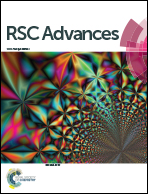High-performance supercapacitors based on novel carbons derived from Sterculia lychnophora
Abstract
In this paper, two nanoporous carbons were prepared from Sterculia lychnophora (SL) by simple hydrothermal conditions followed by a KOH activation step with and without a carbonization process. Structural characterization indicates that the carbon sample without the carbonization process (AC-1) exhibits a cross linked and hole-like structure, a BET surface area of 2589 m2 g−1, pore volume of 1.21 cm3 g−1 and BJH average pore width of 2.78 nm. The carbon sample with the carbonization process (AC-2) shows dozens of nanometer microspheres, a BET surface area of 2660 m2 g−1, pore volume of 1.258 cm3 g−1 and BJH average pore width of 3.321 nm. The electrochemical capacitance behaviors of these carbon materials were investigated in KOH and NaNO3 aqueous solutions in three and two-electrode cells, respectively. By using the NaNO3 electrolyte, the efficient capacitor can work in a wider voltage window of 1.7 V without any significant capacitance fading over 3000 cycles; the highest specific capacitance of 47.8 F g−1 and energy density of 18.5 W h kg−1 are demonstrated. The desirable porous structure and electrochemical characteristics may enable SL biomass based carbon to be excellent electrode materials for high performance electrical energy storage devices.


 Please wait while we load your content...
Please wait while we load your content...